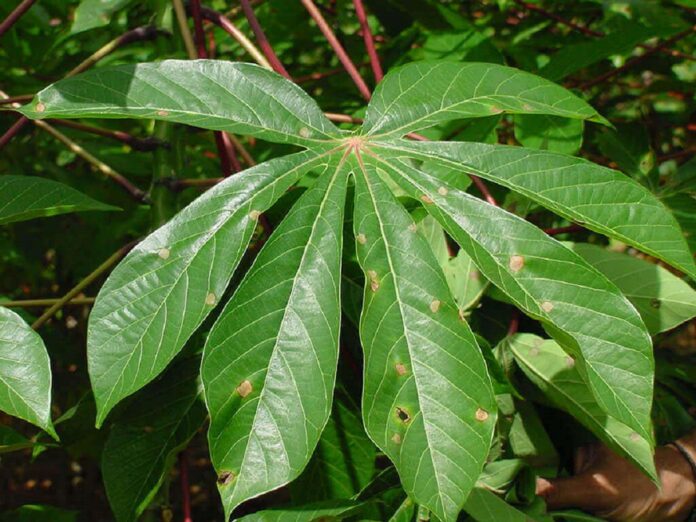Cassava diseases are a major threat to food security in Africa. Diseases of cassava reduce yield and can cause losses of up to 80% and in worse situations, a total loss of produce. This makes it extremely important for farmers to employ all sustainable cassava disease prevention methods to ensure food security in Africa.
How important are the cassava diseases?
The Guide to Identification and Control of Cassava Diseases by Emmanuel Moses states the following as the importance of cassava diseases.
- Cassava diseases cause low yields of edible roots.
- Low yields due to diseases affect the incomes of farmers.
- Food security is reduced by diseases.
- Severe outbreaks of diseases such as cassava bacterial blight can result in famine (in whole communities or countries).
- Cassava diseases that affect stems can lead to loss or shortages in the supply of planting materials.
- Loss of leaves through diseases can affect the availability of leafy vegetables.
- Loss of leaves and poor yield of storage roots can affect livestock production in communities that use cassava as animal feed.
Read also: Detailed guide to good cassava cultivation
Cassava is a very important food commodity in Africa, and as farmers, we need to apply the measures that help to manage cassava diseases.
Now let us consider the various cassava disease prevention and control measures.
1. AFRICAN CASSAVA MOSAIC DISEASE

Use of Resistant Varieties
In cassava disease prevention, it is important to use cassava varieties resistant to the mosaic disease to ensure higher yields. The mosaic-resistant varieties are developed for areas with a high incidence of the disease.
Refer to Facts about improved cassava varieties in Ghana for mosaic-resistant varieties.
However, improved varieties lose their resistance after a number of years of planting in areas of high mosaic disease pressures. Farmers, therefore need to monitor the performances of these varieties to detect the loss in resistance and replace them with new cultivars.
Use of Healthy Planting Materials
Planting materials distribution can also spread the cassava mosaic disease. To prevent the disease, farmers must look out for healthy planting materials. It is a very effective way of preventing mosaic, like other cassava diseases. Farmers must select plants with no symptoms of the disease and use them as planting materials.
To use a material from a branching susceptible variety, use cutting from the branches rather than the main stem. Main stem cutting may sprout with the disease.
If it is non-branching, avoid cutting from the basal portion of the stems which may give rise to diseased young plants after sprouting.
Roguing of Plants
Remove diseased plants showing symptoms of the disease and destroy them. This will help reduce the spread of diseases on farms. Farmers must inspect their cassava farms regularly to ensure effective disease control.
Replace young plants showing disease symptoms with healthy materials to ensure an adequate plant population.
Read also: Cassava Diseases and Identification
2. CASSAVA BACTERIAL BLIGHT DISEASE
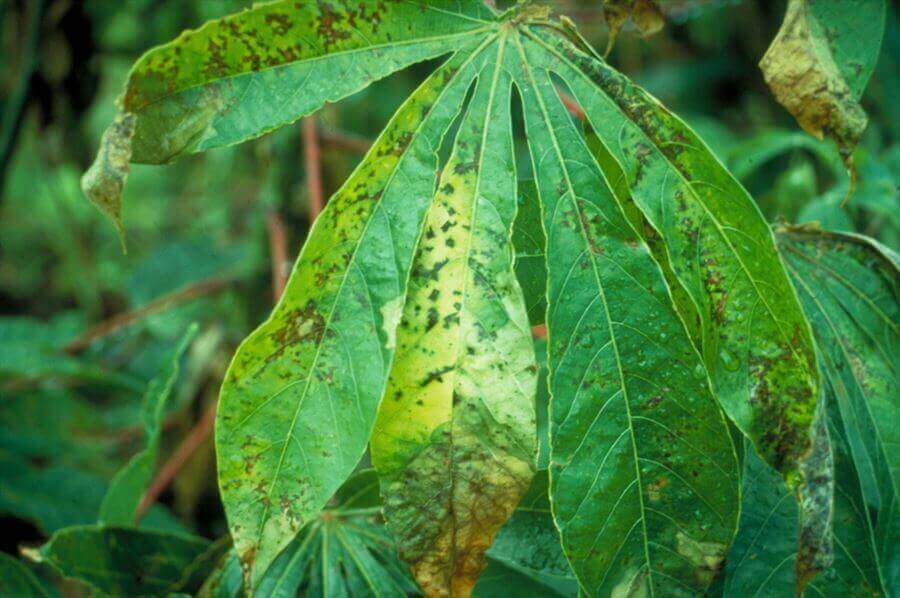
Use Resistant Varieties
In areas where the CBB is endemic, farmers must use CBB resistance varieties if they are to realise sustainable yields.
Roguing of Plants
Farmers cultivating susceptible varieties must regularly search and destroy the plants showing symptoms of the disease by burning them. This activity must follow the first few incidences of rain after the dry season. Early detection and destruction, can prevent or reduce the rate of spread of disease on the farm.
It is, however, safe to eat tubers of CBB-infected plants.
Practice Land Fallow
In cases of an outbreak on the whole farm, farmers must harvest roots immediately and destroy the whole plant (stem, leaves, etc.) by burning. They may also plough them deep into the soil. The land must then be left to fallow for a minimum of 3 years in both cases. The bacterium for CBB is not able to survive outside the host for long periods.
Practice Crop Rotation
In areas where land is scarce, farmers may plant legumes and grains on the same land after the destruction of infected plants. The farmer may return after 3 seasons to grow cassava.
Apply Quarantine Measures
Authorities must monitor the movement of materials across borders to ensure safety with respect to diseases. This will prevent the introduction of diseases to new areas.
Use of Healthy Planting Material
Farmers must consciously harvest stems from healthy plants completely free of any of the described symptoms of the disease. It is generally wise to avoid using planting materials from any farm suspected to be under CBB attack even if symptoms of the disease have not been observed on plants.
Control Pest
Grasshoppers and other insects that can serve as carriers of the bacterium from farm to farm must be controlled using environmentally friendly measures. Controlling grasshopper movement after the early first rains of the wet season can reduce the spread of Cassava Bacterial Blight.
3. CASSAVA ANTHRACNOSE DISEASE
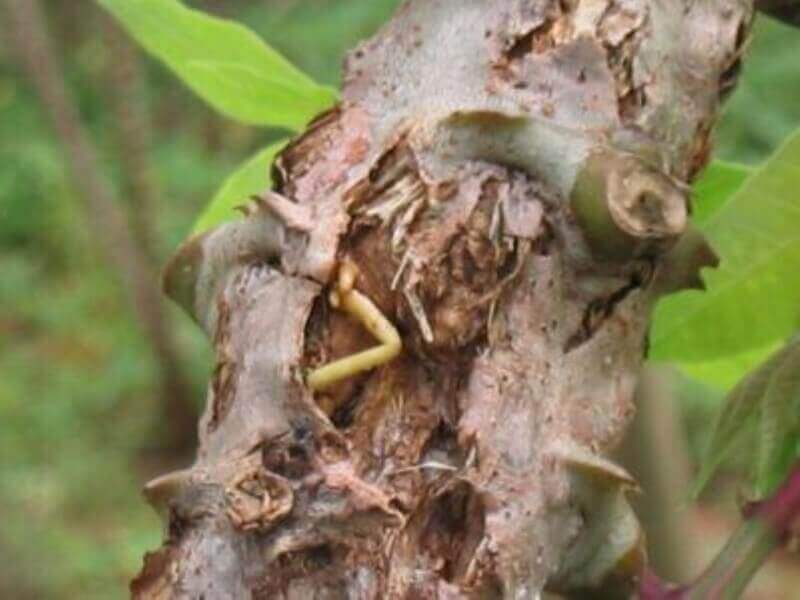
Use Resistant Varieties
In areas of high disease incidence, farmers must use anthracnose-resistant varieties. To realise high yields, cultivation of disease tolerant or resistant is very important.
Use Healthy Planting Material
The farmer must select healthy stems free of cankers and dieback tissues, as planting materials. When planted cuttings are healthy they sprout well and the young growing ones are vigorous and are likely to escape early infections. If the only available materials are canker-bearing, materials must be dipped in recommended fungicides. The fungicides can destroy the disease-causing fungi in minutes.
Practice Good Farm Sanitation
Farmers must destroy infected plants after harvest by burning them to reduce the number of fungal spores and other infective structures that can cause infection in subsequent plants planted on the field.
Destroy Host Range of Causal Organism
Yam, pepper, banana, pawpaw and avocado can also host the fungus that causes cassava anthracnose. Debris of these plants must be destroyed during land preparation before planting cassava.
4. CASSAVA BUD NECROSIS

Use Healthy Planting Materials
Farmers must acquire their planting materials from stems completely free from necrotic lesions. Stems cutting whose buds are infected often fail to sprout, resulting in low plant establishment.
Practice Good Farm practices
Reduce the effects and severity of bud necrosis by using the correct planting distances that allow free movement of air around the plants.
Well-managed weeds also help to control the disease.
Destroy stem pieces bearing necrotic lesions by burning after harvesting to reduce sources of infective fungal spores.
Destroy Host Range or Causal Organisms
Yam, banana and mango can also host the fungus that causes cassava anthracnose. Destroy debris of these plants during land preparation before planting cassava.
5. BROWN AND WHITE LEAF SPOT DISEASES
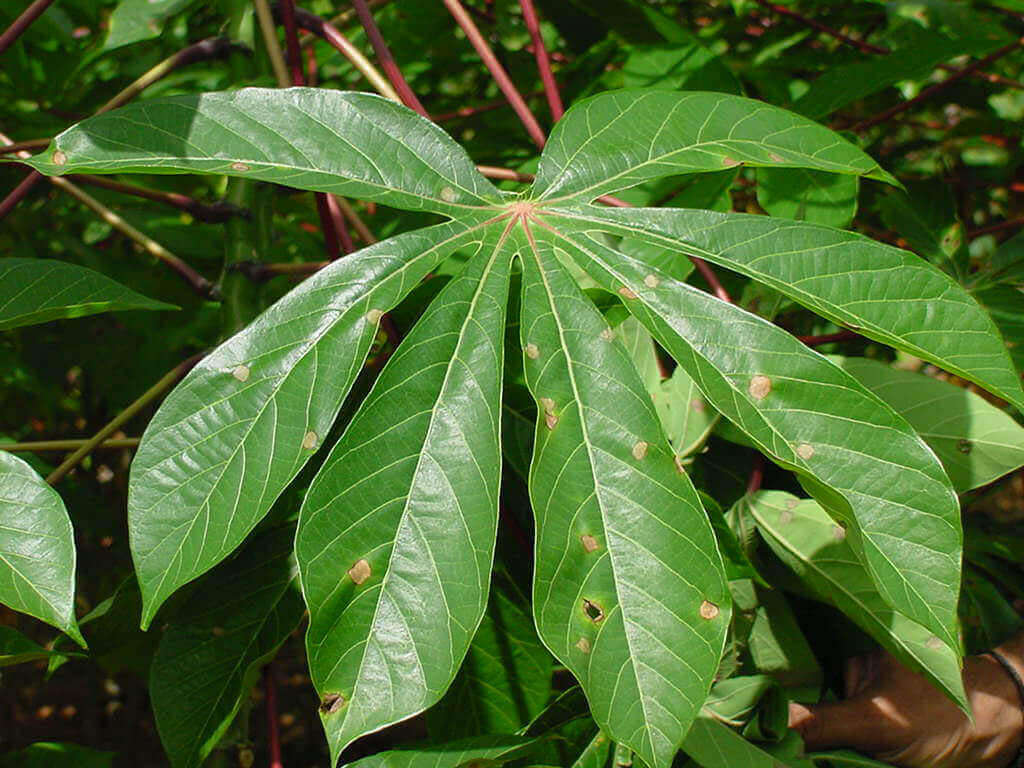
Farmers often see the symptoms of brown leaf spot disease as signs of maturity. They say the spots show up when the cassava is fully grown. They, therefore, do nothing about it.
However, by observation, some susceptible cultivars show brown spots early after sprouting. When large areas of leaves are covered with brown spots, it reduces the photosynthetic areas of the leaves and thus reduces yield. Therefore, it becomes important to control the disease.
Infected leaves and weeds could be sources of spores of leaf spot-causing fungi. Spores from infected leaves are carried by wind or rain splashes and may cause new infections. Weeds also serve as sources for the spread of leaf spot fungi.
Therefore, good weed management can reduce the spread of leaf spot disease.
6. ROOT ROT DISEASES
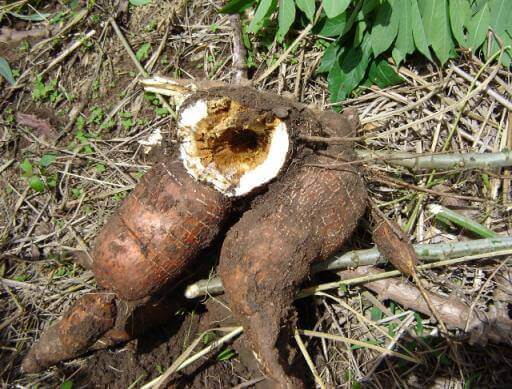
Good Site and Land Selection
Well-drained sandy loam soils are good for cassava cultivation. Farmers must avoid areas that are prone to flooding and water-logging. Waterlogged soils promote root rot disease. Farms should not be located close to rivers and streams. Such areas are likely to be flooded at some time in the year.
Choose lands that have no history of root rot disease and, of course, other major cassava diseases. Look out for the presence of root rot-causing mushrooms and avoid the site. In cases where the land available has a history of root rots, practice good disease management to ensure good yields.
Farmers must make sure the land is fertile. Fertile lands produce healthy plants which are not easily attacked by diseases. Improve soil fertility with farmyard manure.
Use Resistant or Tolerant Varieties
Farmers must always choose disease-resistant or tolerant varieties, if available, as planting materials.
Apply Quarantine Measures
Do not use stems from fields with signs of root rot disease even if they look healthy. They are likely to carry spores of root rot fungi.
To check the introduction of the disease into new areas, adopt quarantine measures.
Practice Good Farm Sanitation
Destroy all plant debris including rotten roots and stems bearing fruiting bodies immediately after harvest to destroy spores of pathogenic fungi. This method in cassava disease prevention reduces disease severity in the next season.
Harvest Cassava Early
When you delay harvesting some rot-causing organisms invade and degrade the storage roots. Early harvesting, therefore, prevents or reduces the incidence.
Adopt Crop Rotation
Continuous cropping of cassava on the same piece of land leads to the build-up of the pathogen population increasing in severity year after year. This is also an effective method in cassava disease prevention and control.
Rotate cassava with grains or cereals periodically (every 3 years) to help reduce the effects of root rot disease.
Allow Land Fallow
Leave lands to fallow for 5 years, after 5 years of continuous cassava cultivation. This can help reduce the incidence and severity of cassava diseases. When practised well, it can help eliminate a disease completely.
Clean Farm Tools
To prevent the spread of disease, clean farm tools such as hoes, cutlasses and other implements before using them on another farm.
Do not plant Cassava as the First crop after clearing Woodlands or Forests
Woody trees may host certain parasitic mushrooms. We advise farmers not to plant cassava as the first crop. In the absence of the woods, these parasites will attack the cassava.
Destroy Host Range
The pathogenic organism causing the root rot disease of cassava may have more than one host. For example; the Polyporus root rot mushroom also attacks yam and citrus. Some fungi of cassava can also attack soybean and sunflower. Farmers should, therefore, be careful in selecting crops for rotation of intercropping.
Reference: Guide to Identification and Control of Cassava Diseases by Emmanuel Moses.
